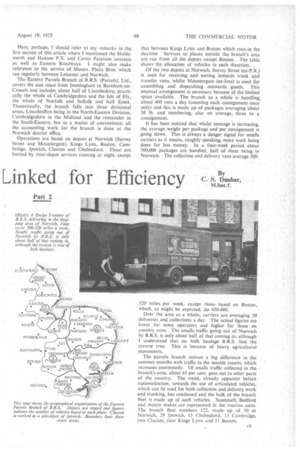Linked for Efficiency
Page 56

If you've noticed an error in this article please click here to report it so we can fix it.
By C. S. Dunbar,
M.Inst.T.
Here. perhaps, I should refer to my remarks in the first section of this article where I mentioned the Holdsworth and Hanson P.X. and Carter Paterson interests as well as Eastern Roadways. I might also make reference to the service of Messrs. Platts Bros. which ran regularly between Leicester and Norwich.
The Eastern Parcels Branch of B.R.S. (Parcels), Ltd., covers the east coast from Immingham to Burnham-onCrouch and includes about half of Lincolnshire, practically the whole of Cambridgeshire and the Isle of Ely, the whole of Norfolk and Suffolk and half Essex. Theoretically, the branch falls into three divisional areas, Lincolnshire being in the North-Eastern Division, Cambridgeshire in the Midland and the remainder in the South-Eastern, but as a matter of convenience, all the accounting work for the branch is done at the Norwich district office.
Operations are based on depots at Norwich (Surrey Street and Mountergate), Kings Lynn, Boston, Cambridge, Ipswich, Clacton and Chelmsford. These are limited by inter-depot services running at night, except that between Kings Lynn and Boston which runs in the daytime. Services to places outside the branch's area are run from all the depots except Boston. The table shows the allocation of vehicles in each direction.
Of the two depots at Norwich, Surrey Street (ex-P.X.) is used for receiving and sorting inwards trunk and transfer vans, whilst Mountergate (ex-Ives) is used for assembling and dispatching outwards goods. This unusual arrangement is necessary because of the limited spice available. The branch as a whole is handling, about 400 tons a day (counting each consignment once only) and this is made up of packages averaging about 38 lb. and numbering, also on average, three to a consignment.
It has been noticed that whilst tonnage is increasing, the average weight per package and per consignment is going down. This is always a danger signal for smalls carriers as it means, roughly speaking, more work being done for less money. In a four-week period about 500,000 packages are handled, half of these being in Norwich. The collection and delivery vans average 300
320 miles per week, except those based on Boston, which, as might be expected, do 450-480.
Over the area as a whole, carriers are averaging 50 deliveries and collections a day. The actual figures are lower for town operators and higher for those on country runs. The smalls traffic going out of Norwich by B.R.S. is only about half of that coming in, although I understand that on bulk haulage B.R.S. find the reverse true. This is because of heavy agricultural movements.
The parcels branch notices a big difference in the summer months with traffic to the seaside resorts, which increases enormously. Of smalls traffic collected in the branch's area, about 65 per cent. goes out to other parts of the country. The trend, already apparent before nationalization, towards the use of articulated vehicles, which can be used for both collection and delivery work and trunking, has continued and the bulk of the branch fleet is made up of such vehicles. Scammell, Bedford and Austin makes are represented in the tractive units. The branch fleet numbers 122, made up of 50 at Norwich, 29 Ipswich, 13 Chelmsford, 13 Cambridge, two Clacton, four Kings Lynn and 11 Boston.








































































































